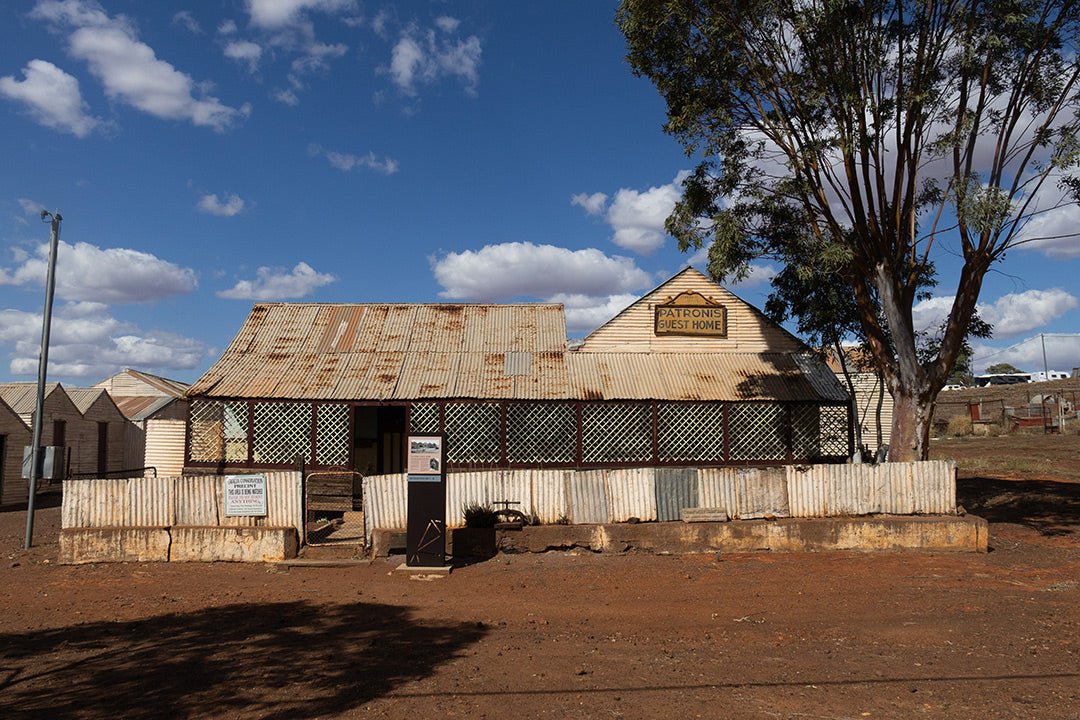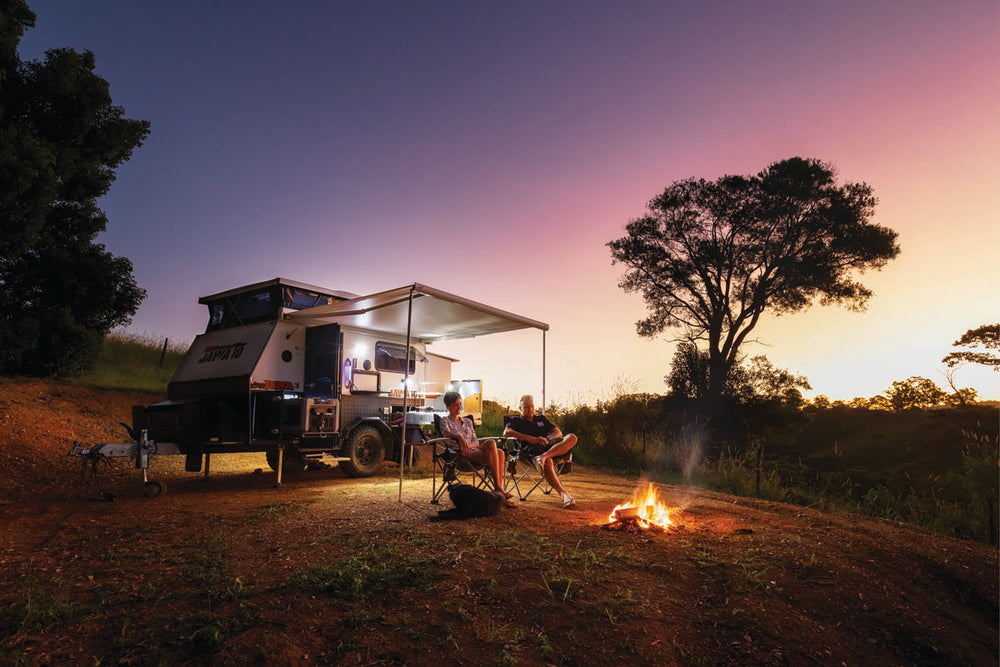

Located 3km from Leonora, in Western Australia’s goldfields region, you can easily spend a few hours wandering around the living ghost town of Gwalia.
Gold was discovered near Mount Leonora, WA, by prospectors J Carlson, F White and A Glendinning in 1896. Named after a Welsh investment syndicate, The original Sons of Gwalia mine was once the second-largest gold mine in Western Australia. In 1898 it was managed by Herbert Hoover, who in 1929 became the 31st President of the USA.
Listed on WA’s State Register of Heritage Places, 22 partially furnished and renovated miners’ cottages, Mazza’s general store (which sold everything from soap to ammunition), Patroni’s Guest House, the Shift Boss’s house, and the mechanic’s shop number plate collection in the little settlement of Gwalia are a tangible snapshot of a vanished era and a glimpse into the history and life of the miners and their families.
 Gwalia mechanic’s workshop
Gwalia mechanic’s workshop
The miners needed to be resourceful: building simple cottages from recycled materials and corrugated iron with pressed tin or limewashed hessian walls papered with newspaper, and dirt, stone or wooden floors. Conditions were harsh. There was no power and residents relied on water tanks. Some single men lived in bough shelters. Mick Omodei was known as Burglar Bill, due to his ability to acquire unclaimed properties.
 The Sons of Gwalia mine
The Sons of Gwalia mine
Around 1000 people, including Italian, Croatian and Yugoslav immigrants, lived in Gwalia during the 1890s. Community gatherings were important and sly-grog shops were popular gathering places for immigrants where they could speak their own language. Galah and polenta as well as Mazza’s goat and pork sausages were local specialties.
Patroni’s Guest House (also known as the Migrants Hostel), built in 1920, was one of several for single workers. Meals were served in the communal dining room: two shifts each day and up to 70 men at every meal on weekends.
 Old miners' cottages
Old miners' cottages A typical kitchen in a Gwalia cottage with a simple plank floor
A typical kitchen in a Gwalia cottage with a simple plank floor
The mine ran at a loss for several years before closing in late December 1963 when the headframe was damaged in an accident. The residents left to find work in other mines, reducing the small town’s population from 1200 to 40 within a few weeks.
Cottages were originally renovated through the Adopt-a-Cottage Project in 1995–1996. Further restoration work has been carried out by the Shire of Leonora.
The two-storey brick and iron Gwalia State Hotel, with its wrap-around veranda and balcony, is a fine example of Federation Filigree style typical of Australian turn-of-the-century hotels.
 Gwalia State Hotel
Gwalia State Hotel
Built in 1903 in an unsuccessful attempt to combat the illegal liquor sly-grog trade, in 1919 the hotel was involved in what is believed to be Western Australia’s first beer strike. Fifty residents drew up a list of grievances and demanded dismissal of the manager. However, the sly-grog trade continued.
The hotel closed in January 1964. Some restoration work has been carried out, but unfortunately the hotel can only be viewed from the street.
 Mazza’s general store
Mazza’s general store
For more interesting stories, visit the mine precinct which includes a museum containing artefacts, history and residents’ memories; the Assay Office used for assessing ore, now displaying the mine’s history; outdoor exhibits including the headframe which carried men, equipment and ore in and out of the mine; old vehicles and a Woodlines steam locomotive which supplied mulga timber to the mine. The poorly paid workers lived in outlying camps.
Hoover House, once the grand home of mine managers, offers a cafe and accommodation. The house was designed in 1897—98 by Herbert Hoover; however, he left Gwalia before completion. You can enjoy sweet or savoury selections from the cafe and the ambience of the sweeping veranda and lush garden.
 A visit to Hoover House, which was once the mine manager's house, is a must to complete this unique experience of Western Australia and rich mining history
A visit to Hoover House, which was once the mine manager's house, is a must to complete this unique experience of Western Australia and rich mining history
The mine was reopened in 1983, and visitors can view the pit from the impressive lookout. More than 1600m below the surface, the mine is the deepest trucking mine in the world. Today around 600 people are employed at the mine: a combination of Leonora residents and fly-in fly-out workers.
Want to stay longer? Take advantage of the free 72-hour RV camping at the Gwalia Museum near Leonora.
Visiting Gwalia, WA
Where is it?
Gwalia is located 3km south of Leonora, 236km north of Kalgoorlie via the Goldfields Highway and 829km east of Perth via the Great Eastern Highway (about a 9hr drive).
Entry to Gwalia is free, but donations are appreciated.
How much time do you need?
Allow two to three hours for your visit, longer if you intend on reading all the information boards. The precinct is open from 9am to 4pm.
The Hoover House Cafe is open from 10am to 3pm.
Where to stay?
Hoover House has three ensuite Bed and Breakfast rooms and a function centre.
For longer stays, there is 72-hour free camping at Gwalia adjacent to the Museum and mine precinct. It is suitable for fully self-sufficient and self-contained RVs and caravans which have a grey water tank. Tents and non-conforming vehicles are not permitted. Hard stand, no shade. Register at the museum before 4pm.
More information
P: 09 9037 7122 / 0419 958 199
Bookings for Hoover House accommodation can be made online.
THE NEXT STEP
If you want to learn the latest caravan news, find the most innovative new caravans, tow vehicles and camping gear or get inspired to plan your next dream WA holiday, subscribe to our weekly newsletter. We promise to send you only the best content.
Related articles:
The Tin Horse Highway outside Kulin, Western Australia
Coalseam Conservation Park, WA: Camp among the wildflowers
Visiting Beringbooding Rock in Western Australia's Wheatbelt







